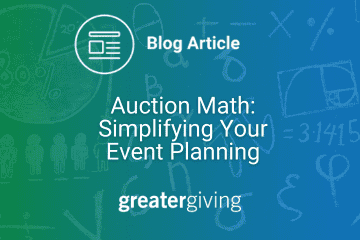
Planning a fundraising auction can seem daunting, but with the right formulas, it’s easier than you think. Auction math works for any size event, making your planning simpler and reducing stress for your committee. Once you understand what’s required for a successful auction—one that meets or exceeds its revenue goal—you can confidently set your procurement goals and define your event budget.
The First Step: Know Your Revenue Goal
Auction planning begins with knowing your revenue goal. Every calculation stems from this key number. From there, you can break down where your auction revenue will come from and what to expect from each revenue stream. Keep these percentage guidelines in mind:
- Live Auctions typically generate 66% of the income from your event.
- Silent Auctions make up the remaining 34% of auction revenue.
The Auction Math Problem: How Many Auction Items Do You Need?
Once you know your revenue goal, use these rules of thumb to determine the value and number of auction items required:
- Live Auction Items yield 75% of their actual value.
- Silent Auction Items yield 50% of their actual value.
Let’s say your fundraising goal is $50,000. Based on this goal, you’ll need to raise the following amounts from live and silent auction items:
- Live Auction Revenue: $50,000 x 0.66 = $33,000
- Silent Auction Revenue: $50,000 x 0.34 = $17,000
Now, you can determine the total auction item value needed:
- Live Auction Item Value: $33,000 ÷ 0.75 = $44,000
- Silent Auction Item Value: $17,000 ÷ 0.5 = $34,000
- Total Auction Item Value: $78,000
Accurate Valuation of Auction Items
Ensuring the value of your auction items is critical to your success. Work with item donors to get accurate valuations. If needed, you can compare similar items online using comparison shopping sites like Bizrate or PriceGrabber to verify the value.
Maximize Your Event Attendance
Once you’ve got the math in place for your auction items, it’s important to gather the right number and type of attendees to meet your revenue goals. Ideally, you’ll want at least 150-200 guests for most events, but here’s how attendance affects your auction:
- For items ranging in value from $30 to $50,000, aim for a minimum of 200 attendees.
- For higher-value items, like those between $75 and $100,000, you may need 300-400 guests to generate the right level of bidding.
Matching Auction Items to Your Audience
Equally important to the number of attendees is ensuring your auction items match the purchasing ability of your audience. It won’t help your cause to offer luxury vacations or high-end artwork if your attendees cannot afford to bid on them. Know your audience and tailor your auction items procurement to fit their interests and budget.
Plan the Right Event Details
Date, location, and logistics all play an essential role in your auctions’ success. Avoid scheduling your event on holiday weekends, unless your auction ties into a specific celebration. And when choosing a venue, look for these features:
- Accessibility: Easy to find with ample parking.
- Capacity: A space that comfortably fits the high end of your attendance estimate.
- Auction Setup: Enough room for auction tables, allowing guests to browse items easily.
Final Thoughts: Making Auction Math Work for You
By using these simple auction math formulas, you can confidently plan an event that meets your financial goals. The right number of items, matched to the right attendees, plus effective budgeting, will set you up for success. Auction math doesn’t just make your event more manageable—it ensures you hit your revenue targets with less stress and more confidence.

I am a newly licensed auctioneer in the state of Mississippi.I’m very interested in learning more about auction math or auction anything.I want to start up my own auction and I need to know everything that I can possibly know about how to really do it.Can you help?
Scott – our auction math is focused at a benefit auction. The dollar value needed to realize the financial goal of a nonprofit. All of our solutions are around helping the nonprofit and our auctioneer partners reach and exceed the fundraising goal for an event. For commercial help, being a part of your state association or the National Auctioneers Association will be really helpful. Hope you’ll stop by and say hi if you make it to Conference and Show in Texas this year.
What is the percentage of the item value that is generally generated in an online auctions?
Hi Scott, thanks for reaching out! Definitely look around our blog, download our famous Auction Planner (http://go.greatergiving.com/planner), and watch our wealth of webinars (http://greatergiving.com/resource-library/webinars.aspx). Once you start up, consider becoming a partner with us here: http://greatergiving.com/partners.aspx.
Best of luck!
Hi,
I am working in an auction house. Currently this auction house is new and we will have our first auction this end of this year. My boss assigned me how to make or generate an auction number? is there any standard rule to follow? because we will have different sales next year.
I hope you could help me.
Thanks
Ed,
the National Auctioneers Association should have some resources for you – both on where you can get bid paddles, software for commercial auctions (ours is for benefit auctions) Generally for commercial auctions, an auction house scans the license of the bidder and swipes the credit card thru a reader, then assigns the bidder number within the software. Any winning bids are then recorded by bid number and it’s easy for you to generate an invoice and charge the customer. This way they cannot leave without paying you. NAA has tons of information and partners that market commercial auction software that should be available on their website. Good luck